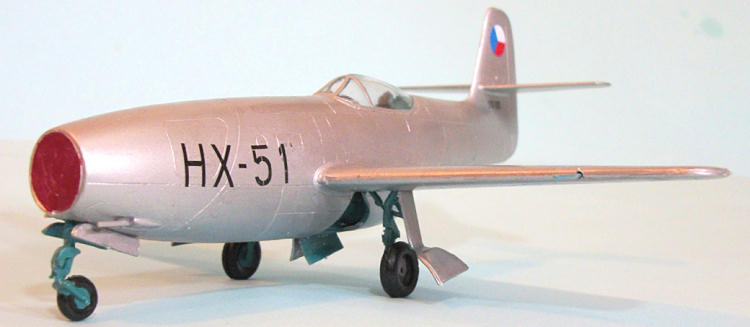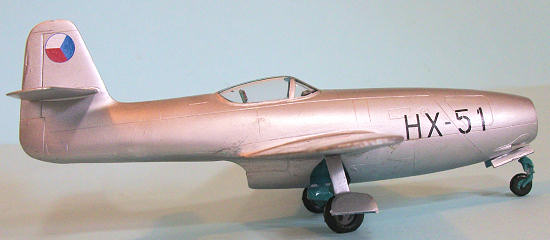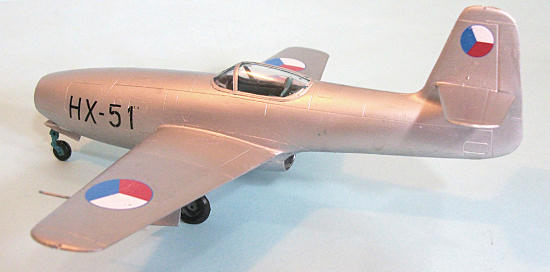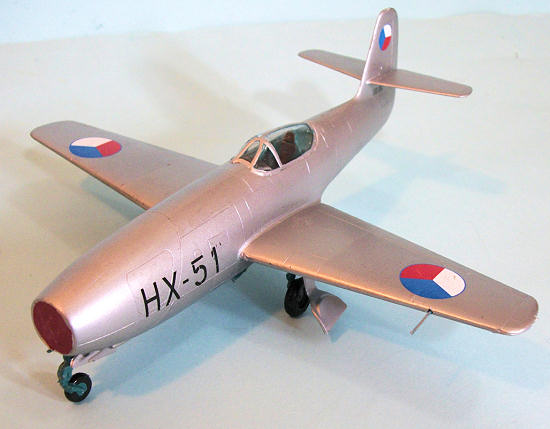
| KIT #: | |
| PRICE: | $25.00 at www.hobbyshop.cz |
| DECALS: | Four options |
| REVIEWER: | Tom Cleaver |
| NOTES: |

| HISTORY |
Developed as a further refinement of the Yak-15 and
Yak-17 fighters, the Yak-23 was a private development by Alexander Yakovlev.
Unlike the previous aircraft which used engines based on
the BMW003, the Yak-23 used a Soviet copy of the British Rolls‑Royce Derwent V
turbojet engine, produced as the Klimov RD‑500.
The wings those of the the Yak‑19. The prototype Yak‑23
first flew July 8, 1947 and was determined to be highly maneuverable, with a
good acceleration and take‑off and climb
 capabilities
thanks to high thrust‑to‑weight ratio; the faults were poor directional
stability at speeds around Mach 0.86 and lack of cockpit pressurization. Despite
being one of the best first-generation straight wing jet fighters, it was
inferior to new swept wing designs such as the contemporaneous MiG-15, and was
seen as a back-up in case that advanced design did not pan out.
capabilities
thanks to high thrust‑to‑weight ratio; the faults were poor directional
stability at speeds around Mach 0.86 and lack of cockpit pressurization. Despite
being one of the best first-generation straight wing jet fighters, it was
inferior to new swept wing designs such as the contemporaneous MiG-15, and was
seen as a back-up in case that advanced design did not pan out.
The Yak-23 entered service with the V-VS in October 1949
and was ordered for export the following year.
310 aircraft were produced by the time production ended
in 1950. Small numbers of Yak-23s were were exported to
In November 1953,
On September 21, 1957, Polish pilot Andrzej Abramowicz
set two FAI world records in a Yak‑23 with civilian markings SP‑
| THE KIT |
This limited-run kit by Bilek is the first
injection-molded kit of the Yak-23 in this scale.
A much more expensive resin kit has been available for
several years.
The kit provides a basically-accurate cockpit, the complex main
gear is adequately created, and the thick canopy is quite clear.
Photo-etch is provided for the instrument panel and seat
belts.
Decals provide markings for the Yak-23s in the Russian, Polish and Czech
aviation museums, as well as
| CONSTRUCTION |

The instructions are about as clear as one usually gets
from an Eastern European limited-run kit, so some experience with previous kits
of this type is helpful.
Fit is so-so.
From the experience of another modeler, I made sure to
attach the wings to the fuselage halves before assembling the fuselage, to
insure goo fit.
 Since this model is going to be displayed in a glass
case out at Planes of Fame, I did not do anything to the cockpit other than
assemble what was there, painting it in the standard Soviet blue-green.
With the thick canopy attached, there is not much fine
detail to be seen, so this works fine.
A modeler who wants to detail this area would do well to
have the ability to vacuform or smash-mold the canopy to get a thin one that
could be posed open.
Since this model is going to be displayed in a glass
case out at Planes of Fame, I did not do anything to the cockpit other than
assemble what was there, painting it in the standard Soviet blue-green.
With the thick canopy attached, there is not much fine
detail to be seen, so this works fine.
A modeler who wants to detail this area would do well to
have the ability to vacuform or smash-mold the canopy to get a thin one that
could be posed open.
All the seams and attachment areas needed putty.
I applied white plastic putty and sanded smooth, then
polished the model and rescribed detail. The nose intake does not fit well, so I
hid that fact by making an intake cover and gluing it over the opening.
| COLORS & MARKINGS |
Be sure to have the area where you are going to apply
the decals thoroughly covered with water when you slide them off, since they
want to settle fast.
The decals are thin and settle easily under a coat of
Micro-Sol.
| FINAL CONSTRUCTION |

For any modeler who wants a complete collection of
Soviet fighter aircraft, the Yak-23 is an important addition, and this kit
provides a good basis to build a nice model, with lots of opportunity for extra
work to detail it up to the standards of other kits.
It is unlikely
another injection-molded kit of this airplane will be produced in 1/48 scale,
and the price of this kit is attractive.
Review kit courtesy of HobbyShop.cz
If you would like your product reviewed fairly and fairly quickly, please contact the editor or see other details in the Note to Contributors.